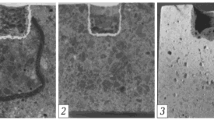Abstract
Channel induction furnaces can operate at temperatures as high as 2000 °C, which requires the use of high-temperature refractory materials resistant to corrosion. CaO, a conventional component of the corundum-containing refractory castables, produces a degrading effect on high-temperature properties; for this reason, low-and ultralow cement materials fail to meet the needed requirements. Therefore a cement-free refractory of the DALCAST series in the Al2O3-MgO binary system based on an Al2O3 fully hydratable binder has been developed. Physical properties (strength and hardening behavior) of a standard low-cement castable and a newly developed product based on the results of their practical use in channel induction furnaces are compared and discussed.
Similar content being viewed by others
References
Vance and Moody, “Steelplant refractories containing alphabond hydratable alumina binders,” Alcoa Technical Bulletin, October. (1996).
Strothmann, Hübner, et al., “High-temperature performance of cement-free and low-cement alumina castables,” UNITECR 95 Congress Proceedings, Vol. 1, pp. 343–350.
Marra, Haling, Soors, Fullington, Vice, and Moore, “Compositional variables and their effect on steel slag resistance and hot strength of high alumina castables,” UNITECR 95 Congress Proceedings, Vol. 2, pp. 675–677.
Jones, “The varied forms of aluminum oxide and their effects on castable refractory properties,” Stahl und Eisen Special. September 1997 (40th International Colloquium on Refractories, pp. 13–142.
Ildefonce, Gabis, Rigaud, and Rebouillat, “Mullitization of Andalusite in bricks and castables,” UNITECR 95 Congress Proceedings, Vol. 2, pp. 899–908.
Zhang, Hübner, Rodrigues, and Pandofelli, “Effect of hydratable alumina binder on the creep behaviour of cement free high alumina refractory castables,” UNITECR 95 Congress Proceedings, Vol. 3, pp. 1337–1346.
Cölle, “Untersuchungen zur Abbindekinetik selbstfließender Feuerbetone unter Anwendung eines Ultraschallmeßsystems,” Keramische Zeitschrift, 54(8), 660–662 (2002).
Ma and Brown, “Mechanisms of reaction of hydratable aluminas,” J. Amer. Ceram. Soc., 82(2), 453–456 (1999).
Author information
Authors and Affiliations
Additional information
__________
Translated from Novye Ogneupory, No. 6, pp. 95–98, June, 2005.
Rights and permissions
About this article
Cite this article
Cölle, D., Jung, M., Gross, H. et al. Cement-free spinel-based refractory materials. Refract Ind Ceram 46, 256–259 (2005). https://doi.org/10.1007/s11148-006-0020-2
Issue Date:
DOI: https://doi.org/10.1007/s11148-006-0020-2




